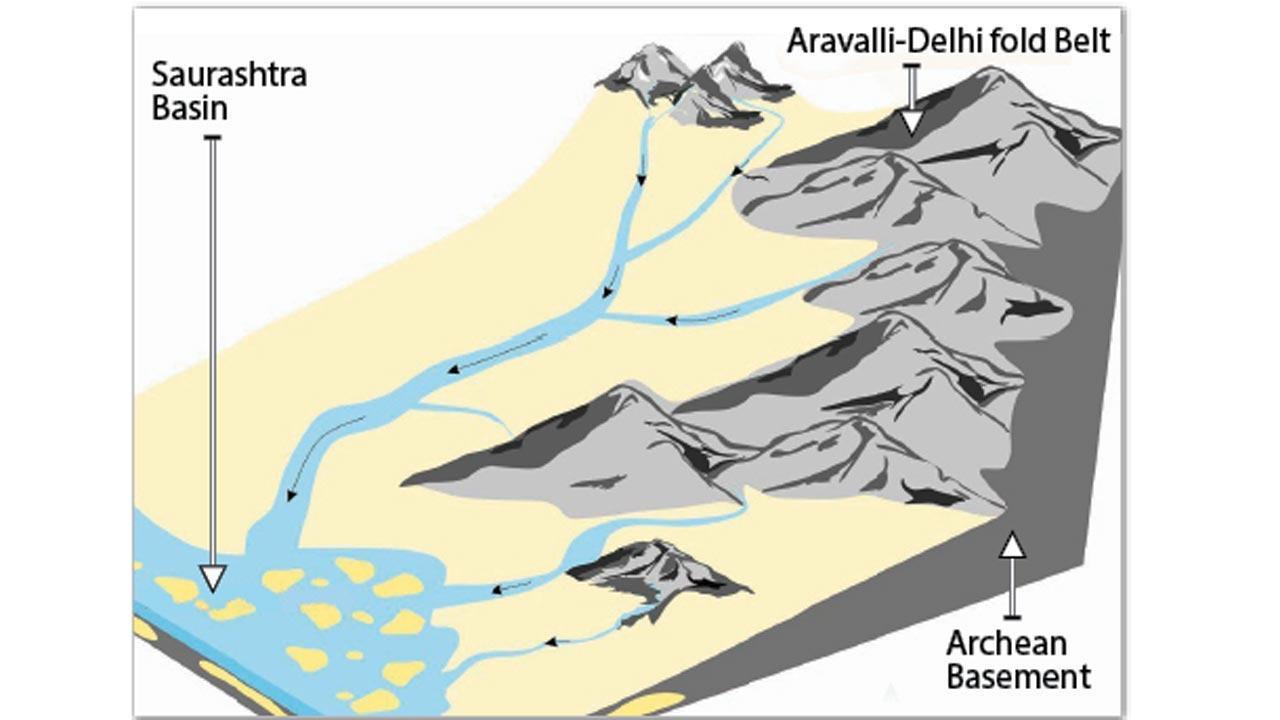Researchers from the IIT Bombay and National Centre for Earth Science Studies analysed sandstones from the age of dinosaurs; study provides valuable insights into India’s past and ancient supercontinent configurations

Graphical representation of sediment flow into the Saurashtra basin
A groundbreaking study led by researchers from the Indian Institute of Technology Bombay (IIT Bombay) and the National Centre for Earth Science Studies (NCESS) has uncovered the ancient geological history of the Saurashtra Basin in western India. Their research dates the minerals found in the sediments, revealing the paths of ancient rivers and the geological evolution of the region. Covering 2,40,000 square kilometres, this basin, hidden beneath volcanic rocks, provides valuable insights into India’s past and ancient supercontinent configurations.
ADVERTISEMENT
Situated across western Gujarat and north of Mumbai’s coastline, the Saurashtra Basin is buried under Deccan Traps, volcanic rocks from eruptions 66 million years ago. Despite these obstructions, recent studies have unveiled a fascinating narrative of India’s geological journey through millennia.
Dr Pawan Kumar Rajak of IIT Bombay’s Department Of Earth Sciences led the study, using advanced dating techniques to analyse Mesozoic-era sandstones. This era known as the age of dinosaurs spans from 252 to 66 million years ago. By examining minerals like zircon and monazite, the team traced the origins and routes of the materials deposited in the basin. “Our research indicates that the Saurashtra basin was formed by the separation of India from Madagascar about 100 million years ago,” says Dr Rajak. “After the separation, the western margin of India became lowlands, while the north and north-eastern parts became highlands,” Rajak added. The study highlights how rivers from the highlands carried sediments to the low-lying Saurashtra Basin. The eruption of Deccan volcanism later covered much of the area, making the study of ancient sediments challenging. However, the current research focuses on rare exposures in mountains, river sections, and road-cuts.
Using electron probe microanalysis (EPMA) and laser ablation-inductively coupled plasma-mass spectrometry (LA-ICP-MS), the team determined the mineral composition and ages. These methods revealed that the primary sources of the sediments were Neoproterozoic and Archean rocks, dating back from 4.5 billion to 540 million years ago.
The study also explores ancient river systems and their impact on landscape evolution. Minerals like rutile and tourmaline indicated multiple geological sources, including granites and metamorphosed clay-rich sediments, traced back to regions like the Aravalli and Delhi supergroup of rocks. Professor Santanu Banerjee, co-author of the study, emphasizes the importance of these findings. “The geological ages indicate that the source rocks formed during supercontinents like Columbia and Rodinia, which comprised all current continents before they split apart.” He added: “This research has practical implications for regional geology and resource management.”
The Saurashtra Basin and nearby areas are potential sites for hydrocarbon resources, making this study crucial for exploration and management efforts. Looking ahead, the team plans to further explore the basin’s minerals to refine their understanding of the region’s geological history. They aim to collaborate with the Oil and Natural Gas Corporation (ONGC) to acquire seismic data for further sediment tracing across the Arabian Sea.
This study represents a significant step in uncovering the ancient geological history of the Indian subcontinent, providing a window into the past and informing future geological and resource exploration efforts, researchers say.
 Subscribe today by clicking the link and stay updated with the latest news!" Click here!
Subscribe today by clicking the link and stay updated with the latest news!" Click here!







